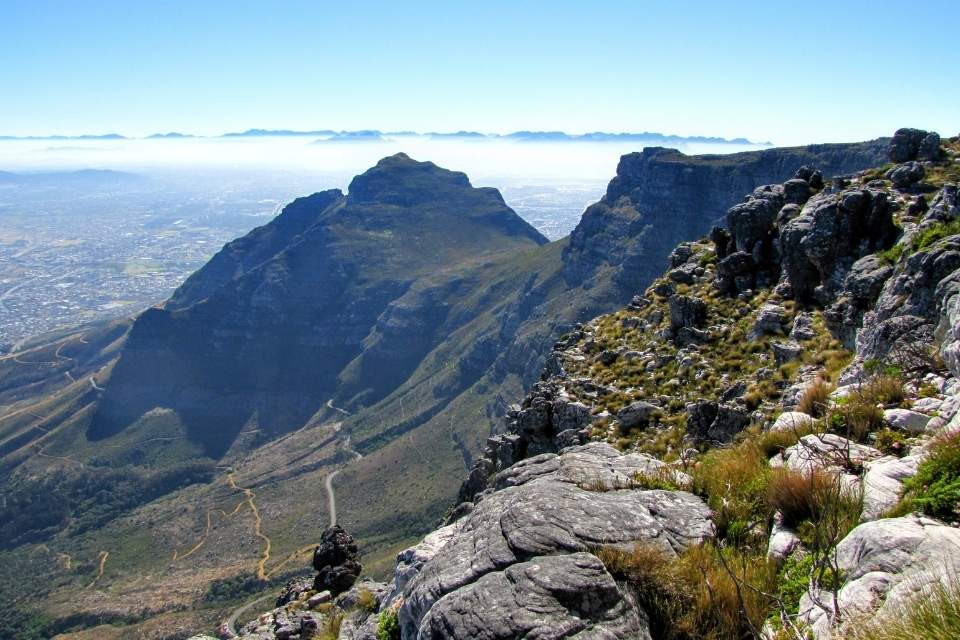Devil’s Peak, flanking the eastern side of Table Mountain, offers a unique perspective over the city of Cape Town and is an integral part of the city’s famous mountainous backdrop.
This striking landmark, shrouded in myths and history, has a lot to offer to both hikers and history enthusiasts.
Article Summary
- A Peak Filled with Lore: Named after a legendary smoking contest between a pirate and the devil.
- Hiking Haven: Offers trails for all fitness levels with spectacular views of Cape Town.
- Historical Landmark: The site of military fortifications with a rich colonial history.
- Biodiverse Ecosystem: Home to unique fynbos vegetation and a variety of wildlife.
- Strategic Visiting Times: Best visited during spring and autumn for favorable hiking conditions.
- Preparedness and Safety: Essential for a successful and enjoyable hiking experience.

Understanding Devil’s Peak
Devil’s Peak is a significant part of the Table Mountain National Park and stands as a sentinel overlooking the city.
Its name, according to local lore, comes from the pirate Van Hunks who supposedly had a smoking contest with the devil himself on the slopes of the mountain.
This legend adds a mystic charm to Devil’s Peak, enhancing its allure.
Hiking and Attractions
Devil’s Peak is a popular hiking destination, known for its challenging trails and rewarding vistas.
The most common routes start at Tafelberg Road and wind their way up through indigenous fynbos, offering panoramic views of the city, Table Bay, and the surrounding mountains.
Whether you’re seeking the thrill of reaching the summit or exploring the lower slopes, there’s a path that will suit your interest and fitness level.
Historical Significance
Devil’s Peak is not just a natural wonder but also a site of historical importance.
It played a strategic role during colonial times, with several military fortifications that were established to defend the Cape.
Walking the trails, one might come across remnants of this military history, providing a tangible connection to the past.
Flora and Fauna
The slopes of Devil’s Peak are home to a wide variety of plant and animal species.
The fynbos vegetation is particularly rich, contributing to the Cape Floral Kingdom’s status as a biodiversity hotspot.
Birdwatchers and nature enthusiasts can enjoy the diverse birdlife and possibly even spot small mammals like the rock hyrax or “dassie,” which are common in the area.
Best Time to Visit
The best time to hike Devil’s Peak is during the spring and autumn months, when the weather is cooler and the fynbos is in bloom.
Summer hikes are also popular but require an early start to beat the midday heat.
Winter brings its own beauty to the peak, though trails can be slippery and more challenging due to rain.
Visitor Tips
- Preparation is Key: Ensure you have enough water, sunscreen, and snacks. The weather can change quickly, so it’s important to wear layers and carry a rain jacket.
- Safety First: Hiking in groups is advised for safety reasons. Be aware of your surroundings and stay on the marked trails.
- Check the Weather: Cape Town’s weather is notorious for its rapid changes. Always check the forecast before setting out to avoid being caught in unfavorable conditions.
FAQs
Is Devil’s Peak more difficult to hike than Table Mountain?
Devil’s Peak offers a range of trails, some of which are comparable in difficulty to Table Mountain’s routes. It’s important to choose a trail that matches your fitness level.
Can you hike Devil’s Peak alone?
While it’s possible to hike Devil’s Peak alone, hiking with a companion or group is recommended for safety reasons, especially on less frequented trails.
Are there any facilities on Devil’s Peak?
There are no facilities on Devil’s Peak itself. Hikers should be fully self-sufficient, bringing all the water and supplies they need.
How long does it take to hike Devil’s Peak?
The time it takes to hike Devil’s Peak varies according to the chosen trail and individual pace. On average, it can take anywhere from 2 to 4 hours to reach the summit.
Conclusion
With its rich blend of natural beauty, challenging trails, and historical significance, Devil’s Peak promises an enriching outdoor experience.
Whether you’re a seasoned hiker or a curious visitor, the peak offers breathtaking vistas, captivating flora and fauna, and a tangible link to Cape Town’s past.
Preparing adequately and respecting the natural environment will ensure your adventure to Devil’s Peak is both enjoyable and safe.

